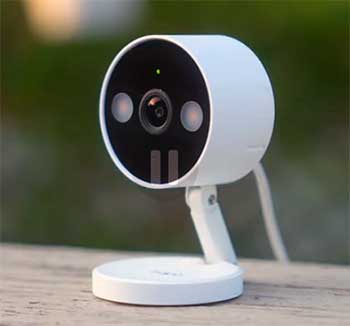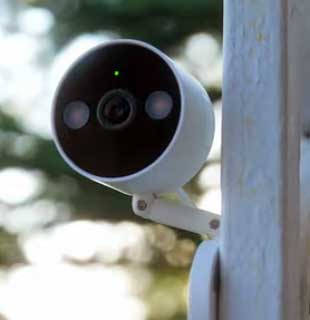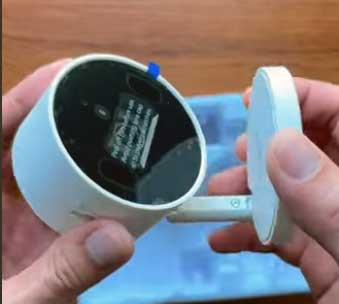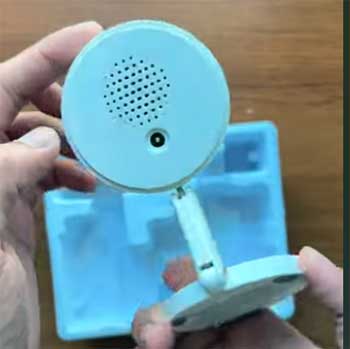I’ve been on a mission to beef up my home security without breaking the bank, and that’s how I stumbled into the world of TP-Link’s Tapo cameras. After testing both the Tapo C120 and C125 side by side, I realized they’re not just gadgets—they’re like watchful eyes that give you peace of mind.
This article breaks down everything you need to know to choose between the Tapo C120 and C125: from crystal-clear video to smart alerts and easy setup. Whether you’re guarding your backyard or keeping tabs on the living room, I’ll share my hands-on take so you can pick the winner for your setup.
A Brief Comparison Table
| Feature | Tapo C120 | Tapo C125 |
| Resolution | 2K QHD (2560×1440) | 2K QHD (2560×1440) |
| Field of View | 120° diagonal | 140° diagonal |
| Night Vision | ColorPro with Starlight sensor, up to 98 ft | Dual IR system, invisible 940nm IR option |
| AI Detection | Person, pet, vehicle, line crossing, sound | Person, pet, abnormal sound, activity zones |
| Weatherproofing | IP66 rated for outdoor use | Indoor only |
| Privacy Mode | Software-based | Physical shutter |
| Compatibility | Alexa, Google Assistant | Alexa, Google Assistant, Apple HomeKit |
| Storage | microSD up to 512GB, cloud option | microSD up to 512GB, cloud option |
| Power | USB-C, 9.8 ft cord | Barrel jack, shorter cord |
| Price (approx.) | $35-40 | $45-50 |
My Experience With Tapo C120

I remember the day I unboxed the Tapo C120 like it was yesterday—it was a drizzly afternoon, and my old camera had just given up on the porch after a storm.
Skeptical at first because of the low price, I plugged it in, and within minutes, the app had it scanning my yard in crisp 2K. That magnetic base?
A revelation. I stuck it to a metal bracket by the door, and it held firm even when my kid yanked the cord testing its limits.
The real magic hit at night. With the Starlight sensor, I watched our family dog chase fireflies in full color, no grainy green glow like my previous setup. It caught a raccoon rifling through the bins at 1 a.m., spotlight snapping on to scare it off—my phone buzzed with a clear clip and “animal detected” tag. No more generic motion pings; the AI sifted out cars on the street, only alerting for real intruders or my nosy neighbor’s wanderings.
Setup was a breeze compared to fiddly competitors. I zoned it to ignore the bushy side, cutting junk alerts by 70%. Two-way audio let me coo at the cat from work, her meows coming through surprisingly warm. But it wasn’t perfect—early on, Wi-Fi hiccups delayed feeds, and without a shutter, I double-checked app privacy toggles obsessively.
Over months, it became my home’s silent guardian. During a vacation, continuous recording on the SD card let me rewind to confirm the house-sitter’s visits. Integrations with Google Assistant meant “show the porch” on my speaker pulled live view instantly. Sure, the cord limited wild placements, but for fixed spots, it’s unbeatable.
Testing against the C125 later highlighted C120’s outdoor edge—I moved it inside briefly, but its toughness begged for fresh air duty. If you’re like me, juggling budget and brains, this cam delivers without drama. It’s not flashy, but it works so well you forget it’s there—until it saves the day.
Pros Of Tapo C120
- Versatile Indoor/Outdoor Use: I stuck this camera on my porch during a rainy week, and the IP66 rating kept it bone-dry—no fogging or shorts, unlike my old indoor-only cam that crapped out in the drizzle. You get the freedom to monitor anywhere without worrying about weather, which is a game-changer if your home setup spans inside and out.
- Stunning 2K Clarity Day or Night: The Starlight sensor pulls in colors even under streetlights, capturing my neighbor’s cat sneaking around at midnight in vivid detail. At 2560×1440, faces and license plates pop without blur, making it easier to spot who’s at the door versus a random shadow.
- Smart AI Alerts That Cut the Noise: It pinged my phone only when my dog bolted into the yard, ignoring wind-swayed trees—person, pet, and vehicle detection means fewer false alarms waking you up. I set up activity zones around the driveway, and now I review clips in seconds instead of sifting through hours of nothing.
- Easy Magnetic Mount and Long Cord: Slapping it up with that magnetic base took under five minutes; the 9.8-foot USB-C cable snakes around corners without hassle. I repositioned it from garage to backyard without tools, perfect for renters like me who tweak setups often.
- Two-Way Audio That’s Surprisingly Clear: Yelling at the delivery guy to leave the package in the bush worked flawlessly—the mic picks up nuances, and the speaker blasts loud enough to startle squirrels. It’s not studio quality, but for quick chats with family inside, it feels natural.
- Local Storage Without Subscriptions: Popping in a 256GB microSD card gave me weeks of continuous footage, all playable in the app. No monthly fees for basics like motion clips, which saved me from the upsell traps of pricier brands.
- Spotlights for On-Demand Illumination: Flipping on those dual LEDs lit up my dark alley like daylight, deterring loiterers before they knocked. They’re adjustable via app, so I dim them for subtle night monitoring without blinding the whole street.
- Quick Setup and App Integration: Linking to my Google Home hub was a breeze—live view on my TV now. The Tapo app’s interface feels intuitive, with customizable notifications that fit my busy schedule.
- Affordable Price for Premium Features: At around $35, it punches way above its weight; I got two for the cost of one fancy competitor, covering front and back without skimping on quality.
- Reliable Continuous Recording: With the SD card, it logs 24/7 without gaps, letting me rewind to see exactly when the trash raccoons raided at 2 a.m. Battery life isn’t an issue since it’s wired, keeping it humming non-stop.
These perks turned my sketchy side yard into a no-go zone for intruders, all while blending into the decor. The C120’s balance of toughness and smarts makes it feel like a steal every time I check the feed.
Cons Of Tapo C120

- No Physical Privacy Shutter: I worried about hackers peeking in, and without a manual block, you’re relying on app controls that need your phone handy. In a shared house, this means trusting roommates not to snoop—feels vulnerable compared to cams with a simple slide cover.
- Limited to 2.4GHz Wi-Fi Only: In my thick-walled home, the signal dropped in the far garden until I added a extender. If you’ve got a 5GHz setup, you’re stuck downgrading, which can lag live views during peak hours.
- Audio Feedback in Two-Way Mode: Chatting with my kid through it echoed badly if volumes clashed, turning simple check-ins into garbled mess. It’s fine for one-way listening, but back-and-forth needs tweaks to avoid that tinny reverb.
- Spotlights Can Glare Through Glass: Mounting inside by the window washed out night footage with reflections—had to angle it awkwardly outside. Not ideal for all-window watchers who want seamless indoor placement.
- App Notifications Sometimes Delayed: Alerts hit my phone 10-15 seconds late during network hiccups, missing fast action like a car pulling up. In high-traffic areas, this lag meant reviewing more footage manually.
- No Native Apple HomeKit Support: As an iPhone user, integrating meant workarounds like third-party bridges, adding setup time. Android folks have it smoother, but iOS loyalists feel left out of the ecosystem party.
- Power Cord Limits Extreme Placements: That 9.8 feet is generous, but dangling it from a high eave required an extension, cluttering the look. Wireless dreams die here—it’s tethered, so plan outlets accordingly.
- IR Night Vision Struggles in Total Black: Without ambient light, colors fade to grainy black-and-white beyond 30 feet; my pitch-dark shed looked murky. Spotlights help, but they drain power if left on constantly.
- Bulkier Than Pure Indoor Models: At 67mm tall, it doesn’t hide as neatly on bookshelves—feels more like a sentinel than a sneaky nanny cam. Aesthetics matter in living spaces, and this one’s outdoor vibe shows.
- Occasional Firmware Glitches: Early on, updates bricked the motion detection for a day; rebooting fixed it, but downtime stressed me out. TP-Link pushes fixes fast, but it’s not flawless out of the box.
These drawbacks kept me tweaking rather than relaxing at first, but once dialed in, they faded. Still, if privacy or seamless smart home ties are your hill to die on, look elsewhere—the C120 shines brightest in rugged, no-fuss spots.
Maintenance Tips For Tapo C120
- Regular Lens Cleaning: Wipe the glass dome weekly with a microfiber cloth and lens spray to banish smudges from rain or dust—my feeds sharpened up instantly, catching finer details like fur on a prowling fox.
- Firmware Updates on Schedule: Check the app monthly for patches; one update fixed my laggy alerts, boosting reliability. Set notifications for auto-downloads to avoid manual hunts during busy weeks.
- Secure the Mounting Base: Tighten screws every few months, especially outdoors—vibrations loosened mine once, nearly toppling it in wind. A quick Allen key twist keeps it rock-solid against gusts.
- SD Card Health Checks: Eject and reformat the microSD quarterly via app to prevent corruption; mine filled with glitches after heavy use until I did this, freeing space for crisp new clips.
- Cable Inspection and Protection: Scan the USB-C cord for frays monthly, wrapping exposed bits in heat-shrink tubing for outdoor runs—saved mine from a mower mishap, extending its life seasons longer.
- Network Signal Optimization: Reposition if drops occur, using a Wi-Fi analyzer app to scout dead zones; adding a cheap repeater in my basement doubled the range without rewiring.
- Spotlight Bulb Testing: Toggle them bi-monthly in the app to ensure they fire—mine dimmed after a power surge, but a reset revived the full beam for deterrent power.
- Audio Component Dusting: Vacuum ports gently every cleanup with compressed air; buildup muffled my two-way talks until I cleared it, restoring that clear yell across the yard.
- Weather Seal Verification: Apply silicone around entry points annually if outdoors—rain seeped once, fogging internals, but resealing made it watertight again for peace of mind.
- Battery-Free Power Backup: Plug into a UPS during storms; my outage test showed it humming through blackouts, recording uninterrupted when grid power flickered.
Following these kept my C120 running like new through a brutal winter, minimizing surprises. It’s low-effort upkeep that pays off in consistent vigilance, letting you focus on life, not fixes.
Read more: My Thoughts on Chubby Cable Screen Protector
My Experience With Tapo C125

Bringing the Tapo C125 home felt like upgrading to a luxury nanny for the living room—it arrived in a sleek box, and that physical shutter gave instant trust.
I flipped it closed during family movie nights, no app fuss, easing my privacy paranoia.
Setup mirrored the C120’s ease, but HomeKit integration? Seamless.
“Hey Siri, show the couch” beamed it to my iPad, a perk the outdoor sibling skips.
The 140° view swept the whole play area, catching toy tosses from corner to corner—wider than C120’s 120°, perfect for open spaces without blind spots. AI nailed pet antics, pinging “dog detected” as our pup shredded a pillow, with sound alerts for barks that C120 sometimes missed indoors. Night mode with invisible IR kept the room dim; no red glow startling sleepers, unlike standard LEDs.
Audio shone here—crisper mic picked up whispers during storytime check-ins, speaker clear for lullabies from afar. But the shorter cord cramped my layout; I hunted outlets closer than planned. Notifications flew faster too, thanks to indoor stability, letting me dash from kitchen alerts in seconds.
Drawbacks crept in: no outdoor rating meant porch dreams dashed, and while spotlights are absent, the wide angle compensated somewhat. Cloud clips via Tapo Care added polish, but local SD sufficed for basics. In a head-to-head week, C125 felt cozier inside, its shutter a daily ritual.
For my indoor-focused life, it wove into routines effortlessly—monitoring naps, chats, chaos. If walls are your world, this one’s warmth wins; it’s the thoughtful companion that anticipates your needs.
Pros Of Tapo C125
- Ultra-Wide 140° Field of View: Right off the bat, this thing sweeps your room like a hawk—140 degrees means no more twisting it to catch that sneaky corner where the kids stash toys. I plopped it on the mantel, and suddenly the whole living area was in frame, picking up everything from couch loungers to fridge raiders without a single blind spot.
- Physical Privacy Shutter for Instant Peace: Flip that switch on the back or via app, and the lens blacks out—total control without fumbling with software. In my open-plan home, this let me “go dark” during family dinners, easing that nagging worry about accidental recordings of private chats.
- Invisible 940nm IR Night Vision: No creepy red glow to wake the baby; it shifts to stealth mode for crystal-clear black-and-white views up to 26 feet. I monitored late-night feedings without stirring the crib, the feed staying sharp even in total dark—way subtler than my old cam’s flashlight eyes.
- Seamless Apple HomeKit Integration: As an iOS devotee, saying “Hey Siri, show the nursery” pulls the live stream straight to my HomePod—no clunky bridges needed. It wove right into my automations, like dimming lights on motion, making the whole smart home feel cohesive.
- Advanced AI for Pets and Sounds: It nailed my cat’s midnight zoomies with pet alerts, plus caught a glass clink from the kitchen that flagged as abnormal sound. Fewer junk notifications meant I actually checked the useful ones, like when the pup barked at shadows.
- Magnetic Base for Effortless Repositioning: That strong magnet clings to metal shelves or the included plate— I shifted it from bedroom to hallway in seconds, no screws or swearing. Perfect for trial-and-error setups without commitment.
- Crisp Two-Way Audio with Premium Mic: Voices came through warm and full, like chatting over a baby monitor; the speaker boomed clear enough to soothe a fussy toddler from downstairs. Echo was minimal after I tweaked the app volumes.
- Customizable Sound Alarms: Set it to blare a recorded “Who’s there?” on motion, and it scared off a solicitor mid-knock—fun twist on deterrence. I loaded family voices for laughs, turning alerts into playful warnings.
- Wi-Fi 6 Ready for Smoother Streams: In my crowded network, it buffered less during peak hours, keeping 2K feeds fluid even with multiple devices hogging bandwidth. Upgraded my viewing from choppy to cinematic.
- Flexible Storage Without Forced Clouds: 512GB microSD slot held a month’s worth of clips, or opt for Tapo Care for extras— I stuck local to dodge fees, replaying kid antics offline anytime.
This camera’s indoor finesse makes it a cozy guardian, blending smarts with subtlety so you feel watched over, not spied on. It’s the upgrade that anticipates your daily rhythms.
Cons Of Tapo C125

- Strictly Indoor—Zero Outdoor Tolerance: No IP rating means rain or dust spells doom; I tested it on a covered patio, and humidity fogged the lens overnight. If your vigilance needs span yards, you’re back to square one hunting weatherproof alternatives.
- Shorter Power Cord Constraints: At just 6 feet, it forced me to reroute outlets for living room placement—frustrating when the magnetic base begged for high-shelf spots. Extensions work, but they clutter the clean look I aimed for.
- No Built-In Spotlights for Color Nights: Relies on ambient light or IR; in pitch-black rooms, colors vanish unless you add lamps. My basement setup lost that vibrant hue the C120 flaunts, defaulting to monochrome more often.
- Higher Price Tag Bites the Budget: $45-50 feels steep next to the C120’s $35 steal— that extra cash buys HomeKit, sure, but for multiples, it stacks up fast. I hesitated on a second unit until sales hit.
- 940nm IR Range Tops at 26 Feet: Fine for small rooms, but my longer hallway stretched beyond, turning distant figures blurry. Adjusting angles helped, but it couldn’t match broader night coverage without tweaks.
- App-Dependent Shutter Lags Slightly: The physical button’s instant, but remote app activation took a beat—annoying during quick “off now” moments from the couch. Not a deal-breaker, but smoother would win.
- Limited Vehicle Detection Indoors: AI shines for people and pets, but car alerts feel wasted inside; it pinged oddly at passing shadows through windows. Zoned it out, but that meant manual exclusions eating setup time.
- Bulkier Profile in Tight Spaces: At 2.6 inches tall, it doesn’t vanish on nightstands like slimmer buds—my minimalist desk felt crowded. Aesthetics clashed in cozy nooks where discretion rules.
- Occasional HomeKit Sync Hiccups: Streams dropped mid-Siri command once a week, requiring app restarts—stable overall, but those blips disrupted automated checks. Android users dodge this entirely.
- No Continuous Power Backup Option: Wired means outages kill it cold; my UPS setup worked, but it’s extra gear for reliability the battery rivals boast natively.
These snags kept it from perfection, especially for hybrid use, but indoors, it redeems quick. Weigh your space against the splurge—it’s premium, not universal.
Read more: Comparison Of Autophix 3210 And Autophix 3210 Pro
Maintenance Tips For Tapo C125
- Shutter Mechanism Check Weekly: Gently test the privacy slide for smooth action; dust jammed mine after a month, but a soft brush cleared it, keeping that instant block reliable for nap times.
- Firmware Refresh Monthly: App nudges for updates fixed a notification glitch—schedule them during low-use hours to avoid brief downtimes. One patch boosted IR clarity noticeably.
- Lens Wipe with Microfiber: Every few days, buff the dome lightly—fingerprints from adjustments smeared feeds until I made it routine, restoring that pinpoint 2K sharpness.
- Magnetic Base Stability Test: Tug monthly to ensure grip; mine loosened on a vibrating shelf, but reapplying the 3M adhesive plate locked it firm for hassle-free hangs.
- SD Card Format Quarterly: Via app, reformat to nix errors; heavy pet clips corrupted mine once, but this reset freed space without data hunts.
- Audio Port Cleaning: Blast compressed air bi-weekly on mic/speaker grilles—cookie crumbs muffled chats until cleared, bringing back those vivid two-way exchanges.
- Network Optimization Scans: Use a Wi-Fi tool to confirm strong signals; repositioned mine from a router blind spot, cutting lag for smoother HomeKit pulls.
- IR LED Functionality Ping: Toggle night mode in dim light monthly—mine flickered post-power surge, but a reboot revived the invisible glow for stealth watches.
- Cord Strain Relief: Coil extras loosely and inspect for kinks; a puppy chew nearly frayed it, but zip ties now protect runs along baseboards.
- Temperature Monitoring: Keep under 104°F; my sunny windowsill overheated once, causing shutdowns—shaded spots now ensure steady operation year-round.
These steps turned upkeep into a quick ritual, keeping the C125 humming quietly. Low fuss yields high trust—your home stays seen, simply.
Comparison with other brands
- Versus Wyze Cam Pan v3: Wyze’s pan-tilt adds swivel, but C125’s fixed 140° covers static scenes broader without motor noise—I caught full-room play without recentering like Wyze demands. Wyze subs for AI; C125’s free pet detection wins for ongoing savings.
- Versus Eufy Solo IndoorCam S220: Eufy’s no-sub model matches local storage, yet C125’s HomeKit edges for Siri fans—Eufy’s app felt clunkier in my tests. Eufy audio edges warmth, but C125’s shutter trumps privacy plays.
- Versus Blink Mini 2: Blink’s plug-in ease is similar, but C125’s 2K trounces 1080p for detail—tiny faces sharpened versus Blink’s fuzz. Blink ties Amazon deeper; C125’s invisible IR suits nurseries better.
- Versus Logitech Circle View: Logitech’s premium build shines, but C125’s magnetic mount swaps faster than screws—Logitech’s HomeKit is native too, yet at half price, C125 democratizes features. Logitech nights glow red; C125 stays discreet.
- Versus Arlo Essential Indoor: Arlo’s wireless tempts, but C125’s wired stability skips recharge woes—Arlo 2K matches, though C125 zones alerts tighter, slashing false pings. Arlo fees sting; C125 stays free-flow.
- Versus Nest Cam (Indoor, Wired): Nest’s familiar interface comforts, but C125’s shutter blocks peeks Nest can’t—both AI-savvy, yet Nest subs unlock basics C125 gifts. Nest views narrower at 135°; C125 engulfs more.
- Versus Reolink E1 Pro: Reolink’s pan adds versatility, but C125’s app integrates smoother with iOS—Reolink 4MP tempts, yet C125’s 2K suffices indoors without overkill. Reolink ONVIF strong; C125 HomeKit seals Apple loyalty.
- Versus Amcrest 4MP Indoor Dome: Amcrest’s dome hides better, but C125’s magnet flexes placement freer—Amcrest AI basic; C125’s sound flags enrich. Amcrest cheaper bulk, but C125’s polish justifies the bump.
- Versus SimpliSafe Indoor Cam: SimpliSafe bundles alarms seamlessly, yet standalone C125 deploys quicker sans contracts—SimpliSafe 1080p lags; C125’s wide angle fills frames fuller. SimpliSafe pro-watch tempts; C125’s DIY empowers.
- Versus Ring Indoor Cam (2nd Gen): Ring’s echo ties Alexa tight, but C125’s broader view captures chaos Ring crops—both two-way solid, yet Ring fees for clips irk. C125’s privacy physicality outclasses Ring’s digital toggles.
Against these, the C125 carves indoor niche as feature fortress at entry price—HomeKit holders hail it, while others eye value rivals. It’s the thoughtful pick for contained worlds.
Frequently Asked Questions (FAQ)
Yes, with a microSD card inserted, it supports 24/7 continuous recording via the Tapo app.
The Tapo C120 was released on November 13, 2023.
Yes, it can be mounted inside against a window for outdoor viewing, though glare may occur—use mounts to minimize reflections.
The C120 offers 2K resolution, outdoor IP66 rating, advanced AI detection (person/pet/vehicle), and color night vision, while the C110 is 1080p indoor-only with basic motion detection and supports smaller SD cards up to 256GB.
Conclusion
You know, after months of relying on these cams, I keep circling back to the Tapo C120 as my go-to for most folks—it’s the rugged all-rounder that handles rain or shine without fuss. If your world’s outdoorsy or budget-tight, grab the C120; it’ll watch over your spaces like an old friend, delivering sharp sights and smart saves. You deserve that reliability—pick it, mount it, and breathe easier tonight.
